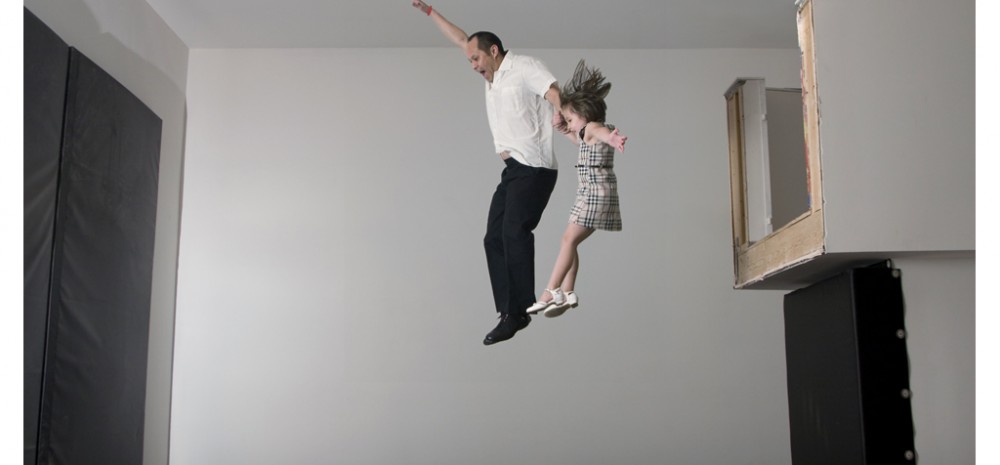Born in 1974 in Naples, Italy
Lives and works in Los Angeles, California
Piero Golia
Manifest Destiny (16 foot jump off the Tsien and Williams ramp onto a 3x12x12 foot red foam mattress), 2008
On January 8, 2008 during my visit to Santa Fe, I was informed that the exhibition design for the Biennial would contain a large elevated ramp circulating throughout the show, creating a directed path for the visitors. When invited to create a site-specific work, I chose to intervene by proposing to cut the ramp at the point it reached the height of sixteen feet and set at the bottom a 3’12’12′ red foam mattress. This will generate a situation where, if the Biennial visitors desire, midway through the exhibition they can jump from the platform onto the red foam mattress or just go back.*
This gesture arose from pure instinct upon first encountering the ramp. The response will be equally instinctive on the part of the visitors  they can jump or they cannot jump. The ramp forces an experience and logic onto the space by interrupting its circularity. I replace this imposition with a physical experience, different from that which was intended.
I remember hearing the Beastie Boys singing, “Ride with me, I’ll take you to the border.†Well, here I take you to the border and I want you to jump. Part shaman and part showman, and, in a way, completely both. The regularly scheduled experience is replaced with a concrete, emotional experience. There is an issue of trust on all sides, and the work is shaped by trust from all involved.
*This text was dictated by artist Piero Golia to art critic Andrew Berardini on April 25, 2008 at 11.37 p.m. GMT.
After having signed waivers, museum patrons will be permitted to jump from Golia’s work. The crash pad is located in the northwest corner of Gallery 4. The actual jump will be approximately five, not sixteen, feet.
Piero Golia’s work addresses issues of identity and the role of the artist through the powerful tools of humor and irony. Although Golia calls himself a ‘small artist’ – referring to his physical sizehis self-deprecation stands in stark contrast to the sometimes Herculean endeavors the artist pursues in order to make something of a legend of himself.
For one of his first works, he successfully spent six months convincing a woman he had met to have his portrait and the words “Piero My Idol†tattooed on her back. In 2005, he vanished in New York and reappeared three weeks later at the Royal Academy of Arts in Copenhagen. Within that period of time, he left no trace of himself at all, crossing borders illegally, leaving no proof of payment and pretty much living the life of a fugitive. Typical of Golia’s taste for creating works that are as much talked about as they are looked at, his adventurous journey was reconstructed by a filmmaker with the help of the head of the Italian Police cyber-investigation unit and a criminal psychologist.
Golia’s gestures are often as grand as they are futile, as illustrated in the work It Takes a Nation of Millions to Hold Us Back (2003), where he had the entire facade of a building removed from its original position in Amsterdam and installed in a gallery space in Paris. The humor in his work is catalyzed by paradoxical situations  the imbalance between means and aims, and the way things sometimes never turn out the way we expect them to.
In 2001, following an invitation to the Tirana Biennale, he rowed across the Adriatic Sea in the opposite direction to migratory movement, thus becoming the first illegal Italian immigrant in Albania, but also playing with the cliches of the emerging artist striving for notoriety on the platform for large-scale exhibitions. Golia turns himself into his biblical counterpart, David, when he fights against the art system and its rules in On the edge (on the crest of the wave) (2000) – a performance he did for the Artissima art fair in Turin – by climbing a 7 meter high palm tree and threatening to come down only if a collector would buy the photo of the work.
He now lives in Los Angeles, a place that blurs the boundaries between reality and fiction, making it the perfect setting for his exploration into the process of myth-making and his ironic outlook on contemporary society. In 2005, Piero Golia and Eric Wesley founded The Mountain School of Arts, an educational institution that aims to become a new spot on the cultural map of the city of L.A.
Patrizia Sandretto, President
